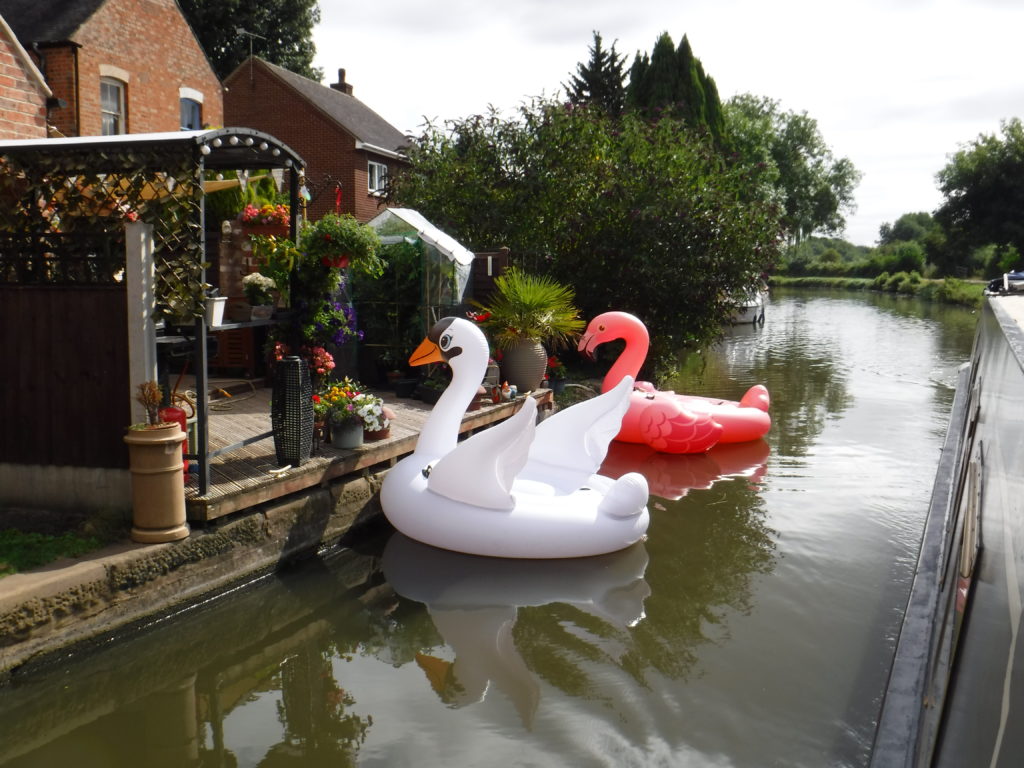Turning points
This morning we said goodbye to the Grand Union Canal and the River Soar. The Soar joins the River Trent and the Erewash Canal in a waterway junction so complicated you needs signs to navigate it.

We turned upstream on the Trent. Compared with the Soar and then Nene it is a huge expanse of river, but one lock later there is another useful sign.

The Trent and Mersey Canal. We have nothing but canals from now on. No more annoying river currents, no more high banks blocking the view, and no more meanders than Telford intended.
Not that the canals aren’t without their dangers.

Yep, giant inflatable battle swans. Granted, one is disguised as a flamingo, but you can’t fool me with pink body paint.
We still have a few more broad locks to deal with. We had company for most of them today, though, and it’s always easier with two boats in the lock, or a boat coming the other way so you don’t have to close the gates after you leave. Here’s Paula wrangling the boat into a deep broad lock.

We moored up in the little village of Swarkestone, a few miles from Derby. This was another turning point, on of the most significant in Scottish history. Yes, I did say Scottish. December 5th, 1745, and Charles Stuart, Bonnie Prince Charlie, and his invading army of Highlanders are camped here. So far the Highlanders’ military tactics of charging straight at the enemy and giving them a right seeing to have proved to be too much for the government troops. But winter is coming in, the Scots are badly outnumbered, and there has been no sign of support from English Jacobites or the promised supporting invasion from France. Stuart meets with his supporters, and they decide to turn around and return to Scotland.
The government army followed the Scots back to Scotland. The following spring, the Scots made the mistake of charging straight at an army that had been trained not to run away. (Military genius often consists of simple little things.) The battle of Culloden was over in about an hour, and the Scots were slaughtered.
What would have happened if Stuart had kept going at Swarkestone? Well he was outnumbered and the government troops were learning how to deal with the Highlanders. His army would still have been defeated, but in the middle of England rather than in deep in the Highlands where it was easy for him to escape. He would have been captured and executed, and Scotland would have escaped two hundred and fifty years of maudlin songs about the escape and return of Bonnie Prince Charlie.
This building would have been over a hundred years old when the Jacobites were here.

It was built in the 17th Century as a viewing pavilion for some sort of game, probably bowling. After falling into disrepair, it has now been restored and is available as a holiday rental. The two towers at the top house the bathroom, and the stairs to the bathroom, so you have to cross the roof every time you need to have a pee. The publicity materials put a brave face on this.
Glimpse the stars as you flit across the roof to the bathroom in one of the turrets.
Thanks, but no thanks. I’ll just piss out of the window if that’s OK. It’s a lot more 17th century.